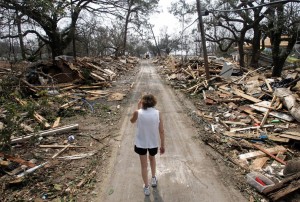
Mesothelioma is a rare form of cancer caused by asbestos exposure. The disease develops in the tissue that covers the internal organs, called the mesothelium. While the cancer most commonly develops in those who have had on-the-job exposure (ie. mechanics, construction workers), sometimes there are unforeseen disasters that spread the carcinogen far beyond its point of impact. In these instances, those exposed to asbestos multiplies significantly, and it may be nearly impossible to decipher the source of the carcinogen once it becomes airborne.
Perhaps the best illustration is Hurricane Katrina, which devastated our city back in 2005. The impact of the hurricane included ecological damage, but also chemical and hazardous materials released as old buildings crumbled under the eye of the storm. The widespread demolition and renovation activities also released asbestos fibers into the air. By the Environmental Protection Agency’s (EPA) own admission, the agency’s assurance that public health was protected from risks associated with inhalation of asbestos fibers was limited because it did not deploy air monitors in and around New Orleans neighborhoods where demolition and renovation activities were concentrated. There were several challenges to the EPA’s management of the cleanup process, such as the agency’s lack of authority over landfill decisions, or the fact that health effects from exposure to asbestos also apply to short-term exposures. Further, many homes are not subject to the EPA’s asbestos emissions standards. These challenges would still likely repeat themselves if another natural disaster were to affect New Orleans.
Liability if the Tortfeasor is Unknown
In traditional tort law, the legal doctrine of alternative liability allows a plaintiff to shift the burden of proving causation of injury to multiple defendants, even if only one of the defendants was actually responsible. However, there must be at least one defendant that is shown to have breached a duty of care for this theory to work. In the case of such natural disasters, no particular defendant can be pinned down for releasing asbestos into the air and environment, making recovery extremely difficult. Liability will then likely shift to those responsible for the cleanup, the government, if it can be shown that you had asbestos exposure through cleanup activities. The EPA and the state and local authorities under its direction were responsible for cleaning up the superfund site and maintaining the regulations to protect the public health. A plaintiff must still be able to show that the agency breached a duty of care in managing its cleanup activities in order to recover.
Get Legal Help for Your Asbestos-Related Illnesses
Injuries caused by defective products or asbestos impose substantial hardship on the victims as well as their loved ones. Harrell & Nowak represent people who have suffered from mesothelioma in litigation against companies who use the material. Many individuals and their families have filed successful mesothelioma lawsuits against asbestos manufacturers, securing compensation for the immense physical and emotional devastation that can result from a mesothelioma prognosis and other asbestos-related diseases. If you or a loved one has been injured, contact our New Orleans Mesothelioma litigation law firm today for a free, confidential consultation.
